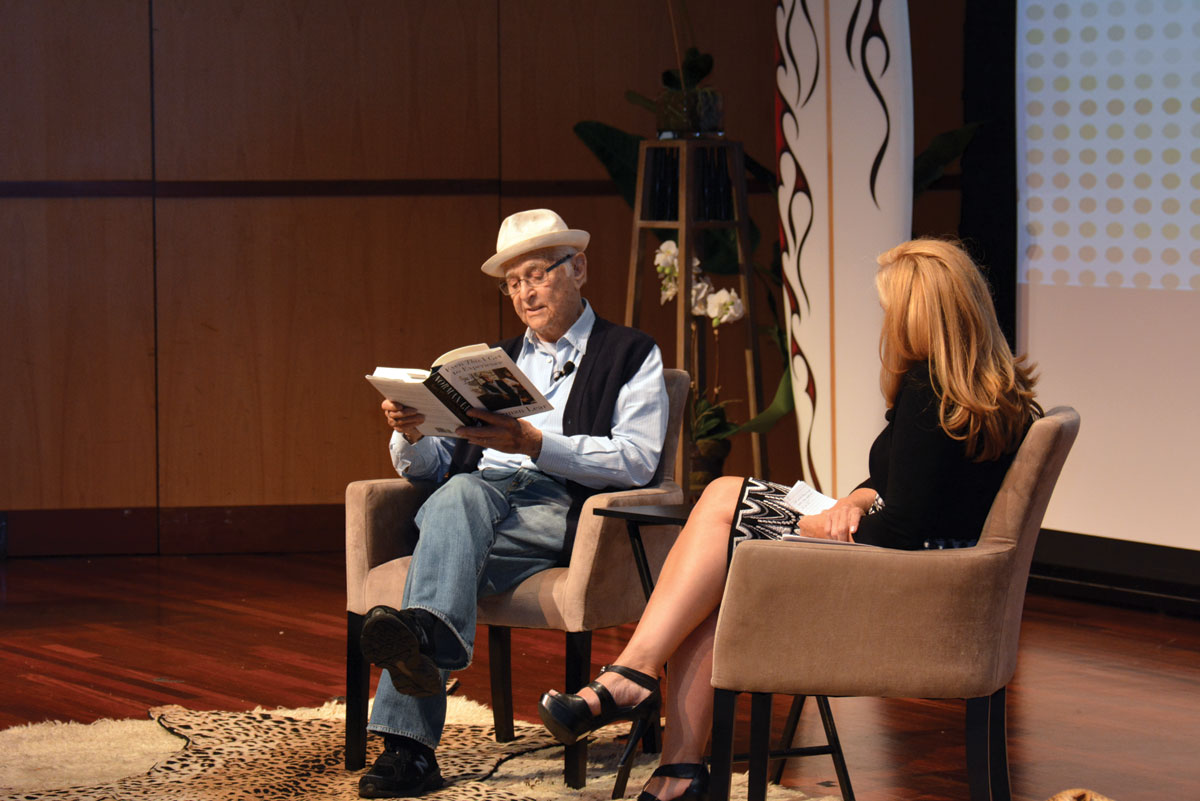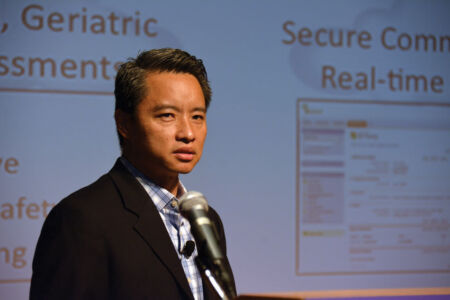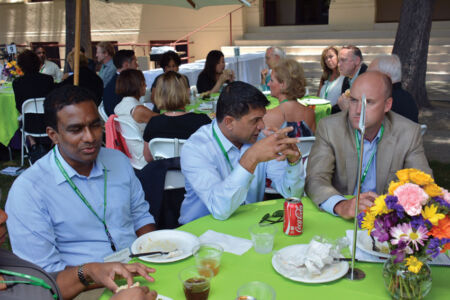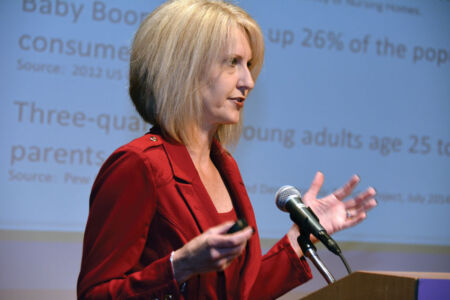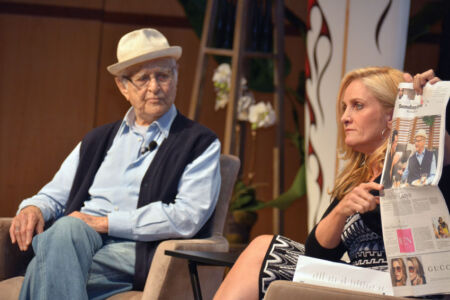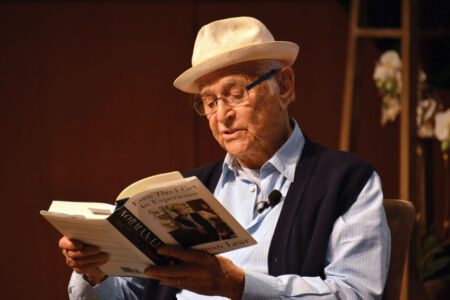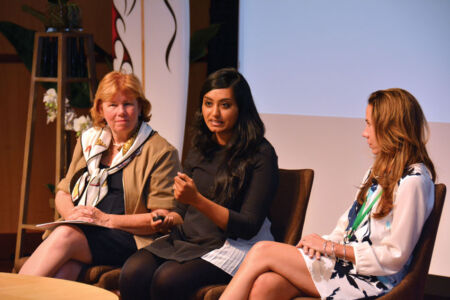OLD REALLY IS GOLD
Author Norman Lear reads a chapter from his book during a talk with MSNBC show host Alex Witt (r). (Amar D. Gupta | Siliconeer)
As a South Asian entrepreneur, attending the Silicon Valley Boomer Venture Summit (boomerventuresummit.com) was a huge eye-opener. The summit was held, June 30, at Santa Clara University. Listening to Norman Lear, 92, was an absolute delight as he spoke about his philosophies and how to be an innovator by never looking back but always forward. Newer South Asian business models need to focus on this booming market segment and come of age with the Silver Economy. Some like Dr. Ambika Bumb are already doing just that, there is still room for more, writes Amar D. Gupta.
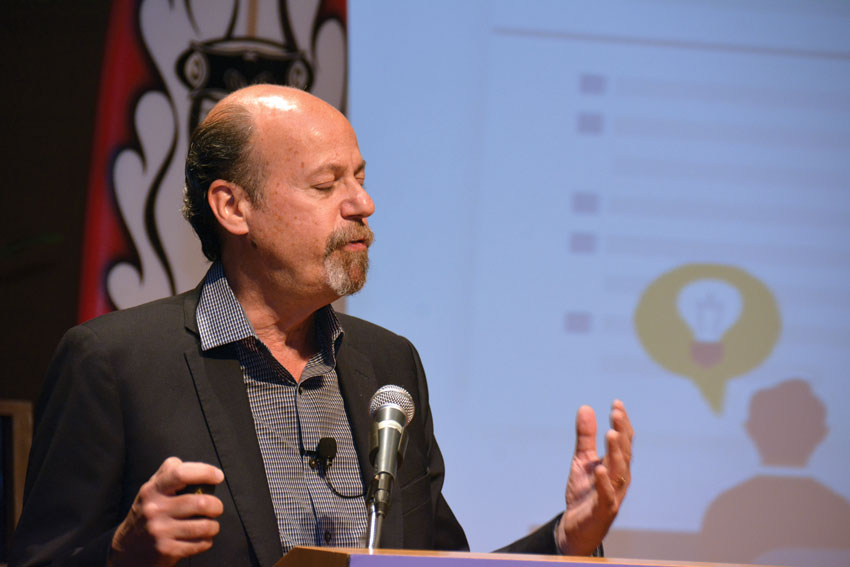
The summit co-produced by Santa Clara University (scu.edu) and Mary Furlong & Associates (maryfurlong.com) was a power-packed offering of insights into the Baby Boomer generation’s needs and how various organizations such as AARP (aarp.org), Lennar Homes (lennar.com) and startups like LivWell Health (livwellhealth.com) were addressing these needs.
The event brings together entrepreneurs, leaders in the field of aging and the venture community to create a unique forum to explore, share and design products and services that will dominate the baby boomer market in coming years. In addition, this program is designed to teach entrepreneurs how to think through a business.
Among the many engagements, the keynote conversation with Norman Lear, 92, was an absolute delight. Mr. Lear was in conversation with Alex Witt, MSNBC anchor and host of “Weekends with Alex Witt.”
He spoke about his philosophies and health and career longevity, how to successfully disrupt the status quo for social good, and how to be an innovator by never looking back but always forward.
Mr. Lear enthralled a spellbound audience as he discussed stories from his recent book Even This I Get to Experience. The book reading was received with thunderous applause.
Among many other speakers, there was a talk by Dr. Ambika Bumb, winner of last year’s $10,000 Boomer Business Plan Competition on the impact of winning the 2014 business plan competition on her business and an update on the progress made in the past year.
This year the Business Plan Competition saw six finalist entrepreneur groups compete for the $10,000 grand prize by presenting their boomer business plans before a panel of judges comprised of leaders in the field of aging and the venture capital community.
As expected, there were not many South Asians at this conference, unlike The IndUS Entrepreneur (TiE) (#TiESV) (tiesv.org) event that happened in May. There were some from TiE itself, but that was that.
The Indian American population has matured enough to the point where it should consider looking into the present and future Silver Economy of its own, says TiE veteran, Dr. Sanjaya Kumar co-founder and managing director of Synepta Group, Inc. (syneptagroup.com), who was also one of the judges at “What are Your Investing Priorities?” panel for this year’s competition. According to Kumar, it is more of a “lack of awareness” issue that South Asian entrepreneurs are not flocking this ripe market.
We often hear about Uber (uber.com) and Lyft (lyft.com), associating them with a younger generation who are more tech-savvy and likely to use technology to avail of a service. How many know about a DShofer (dshofer.com), a service where you can get a driver on demand to drive you around. Founded by Farhat Ali, this service is of great value for the boomer generation, especially when they need to get to a doctor’s appointment in a hurry.
Dr. Ambika Bumb, founder & CEO of Bikanta Corporation (bikanta.com), is developing nanodiamonds and imaging instruments that redefine the boundaries of medical optical imaging, allowing researchers and doctors to detect disease, such as cancer, at the molecular level. She is an exemplary model of entrepreneurship that is working towards serving the boomer generations needs. She is also the winner of last year’s Boomer Venture start-up competition.
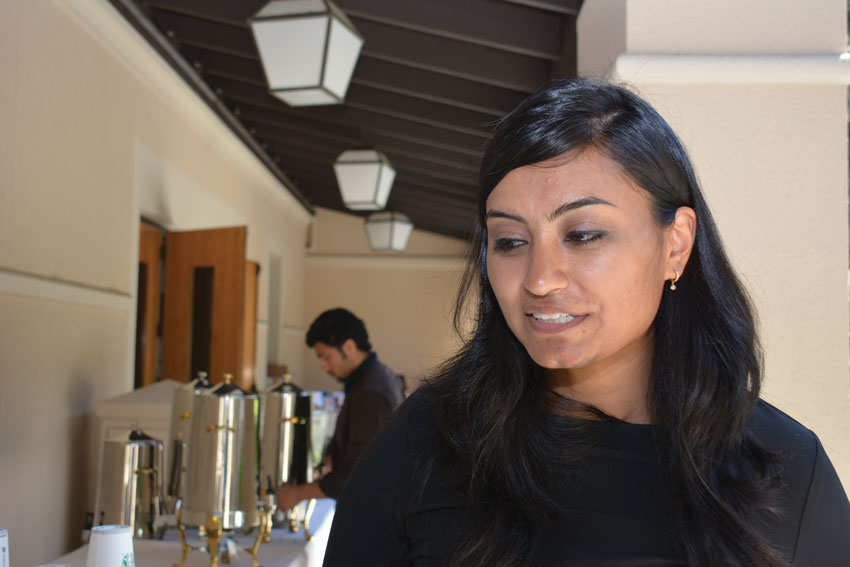
In an interview with Siliconeer, Dr. Ambika Bumb talked about her research.
Siliconeer: What was the idea behind Bikanta, how did you come up with it?
Ambika: My background is in nanomedicine. That’s what I did my Ph.D. and my post-doctoral work in. I met a physicist at a conference who was trying to solve a very particular problem related to single molecular imaging. He was trying to track something. They didn’t have good technology to do that with. There were a lot of signal loss issues that happen in optical imaging.
I had heard about nanodiamonds. We decided to dive into a project to see if we could make nanodiamonds useful for these kinds of bio-medical applications.
Siliconeer: When you say diamonds, as a layman I understand jewelry. What is nanodiamonds?
Ambika: (Laughs) Nanodiamond really is diamond dust. It’s diamond particles that are crushed down to a hundred thousand times smaller than a single strand of hair. They have certain color centers that have been created in them, that give them the optical imaging properties that we can then use, so they’re very exquisite in their imaging capabilities. What this means is that you can have signal to noise ratios thousand-fold better than what current agents offer. They are not toxic, very bright. You can think of them like tiny little flashlights with infinite battery life.
Siliconeer: How does nanodiamonds help the baby boomer generation, or for that matter, mankind in general?
Ambika: The whole point of this is that we are trying to use it to detect diseases earlier. Right now, about 40% of the population gets some form of cancer. [For men, risk of developing cancer is 43.3% and for women 37.8% (http://www.cancer.org/cancer/cancerbasics/lifetime-probability-of-developing-or-dying-from-cancer) Lifetime Risk of Developing Cancer: Approximately 39.6 percent of men and women will be diagnosed with all cancer sites at some point during their lifetime, based on 2010-2012 data. (http://seer.cancer.gov/statfacts/html/all.html)]. We’ve gotten good at figuring how to treat them but all those treatments will be more effective if they are diagnosed much earlier. It helps the patients, it helps the families, but finding tumors when they are the early metastasis state, very small, when they are micro in size, that’s where we need better tools to highlight and detect them.
Siliconeer: So do nanodiamonds only help in detecting early tumors, or do they in general help with early detection of other ailments, for example liver or kidney disease?
Ambika: This technology can be used to target other diseases as well. We are focusing on the cancer right now because that’s where a lot of our in-house expertise is but as a tool, we can attach to really any kind of targeting agent and we can go after other diseases as well. A lot of the people who are working with us, our partners and customers are actually taking this in other directions outside of cancer.
Siliconeer: Tell us about your business plan for 2014. How you did it, what you did, how did you win the award?
Ambika: We had just started the company a few months before last year’s competition. At that time we were still gathering our team together. We had put together a really strong business plan, examined the market, and really thought through how we were going to go to the market. We have a two-revenue approach. The long-term target is in the clinic and in patients, but that is a very long process. So we had an early revenue stream as well, which is providing these technologies to academics, to industry partners who are developing different kinds of imaging tools. So, we have that which we are going to actually start having revenue from this year, and so describing that and how we are going to de-risk the company for the longer goal that we have, I think that probably played a role. In all of this our partnerships with the National Institute of Health (nih.gov) definitely are a big part of it as well. That’s where I helped to develop the technology and we are still working with them on these things.
Siliconeer: Where do you see it going forward?
Ambika: Right now we’re very excited about having this ready to start being used this year. It is in the research mode but to the point where we can actually start selling it, that’s where we are just gearing up to, being able to manufacture at that scale.
Science really is not that fictional anymore and “old” really is “gold.” The boomer generation is a fairly underserved area as far as South Asian entrepreneurs are concerned. It may be prudent to say, you’ve already caught the young, now grasp the old and age with them.
(Amar D. Gupta wrote this article as part of a Silicon Valley Boomer Venture Journalism Fellowship, a collaboration of New America Media and Mary Furlong & Associates).
